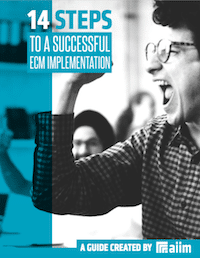The AIIM Blog
Keep your finger on the pulse of Intelligent Information Management with industry news, trends, and best practices.
Big Data | Intelligent Information Management (IIM)
When Systems Don't Talk to Each Other In my organization, we have dozens of corporate systems, and all of them do really important things as part of the work of the organization. But if somebody wants to ask a question like, "How are we providing services into a particular community?" and "What are the types of services in a particular community we're offering over time?" - we have to go to multiple systems to answer these sorts of high-level questions.
Share
Artificial Intelligence (AI) | Big Data
If you are new to AIIM, you might be wondering what AIIM means when we say "information," which we admittedly say a lot. My favorite explanation of information is from Steve Weissman, CIP, who told me that he simply refers to information as "stuff in a box." Information represents all the data you manage within your organization. Information means both structured and unstructured data.
Share

Making an ECM implementation successful requires planning and attention to detail. The best way to create the right solution is to identify organizational goals and priorities. Learn how to manage a successful implementation in our free guide.
Artificial Intelligence (AI) | Big Data | Data Management | Knowledge Management
What is Generative AI? Generative AI has caught fire in the industry – almost every tech vendor has a ChatGPT-like offering (or claims to have one). They are claiming to use the same technology – a large language model (LLM) (actually there are many Large Language Models both open source and proprietary fine-tuned for various industries and purposes) to access and organize content knowledge of the enterprise. As with previous new technologies, LLMs are getting hyped. But what is generative AI?
Share
Big Data | Compliance | Electronic Records Management (ERM) | Information Governance
This article was written by AIIM Florida Chapter Board Member Alvaro Arias Cruz, District Director of Archives of Bogotá. It was originally published in the AIIM Florida Chapter Newsletter in April 2023. Learn more about the AIIM Florida Chapter at https://aiimfl.org/. Colombia has one of the most robust and comprehensive archives laws in the Latin American region, identified as the General Archives Law (Law 594 of 2000). Through this state norm, Colombia and all its public institutions have made substantial progress in document management and archives administration, so much so that it has been recognized nationally and internationally as a reference for several countries to develop their own legal frameworks on their public archive policies.
Share
Highly successful organizations understand the importance of acquiring and keeping top talent. HR departments are starting to tap into a massive competitive advantage by leveraging data analytics to identify top performers before they're hired, improve their retention rates, and keep their employees happy and engaged. As the technology for dealing with large sets of employee data continues to advance, this competitive advantage will soon become the new normal. The time for human resource professionals to start embracing data analytics is now.
Share
We have a small problem with Big Data...the majority of us just don't completely understand it. Sure, we've all heard the term "Big Data" - but I'm willing to bet if I asked a room full of people what it was, I'd get puzzled looks and shrugged shoulders from about half the room...and I'm sure I'd lose most of the other half of the room if I followed up that question by asking how to leverage big data for real business value.
Share